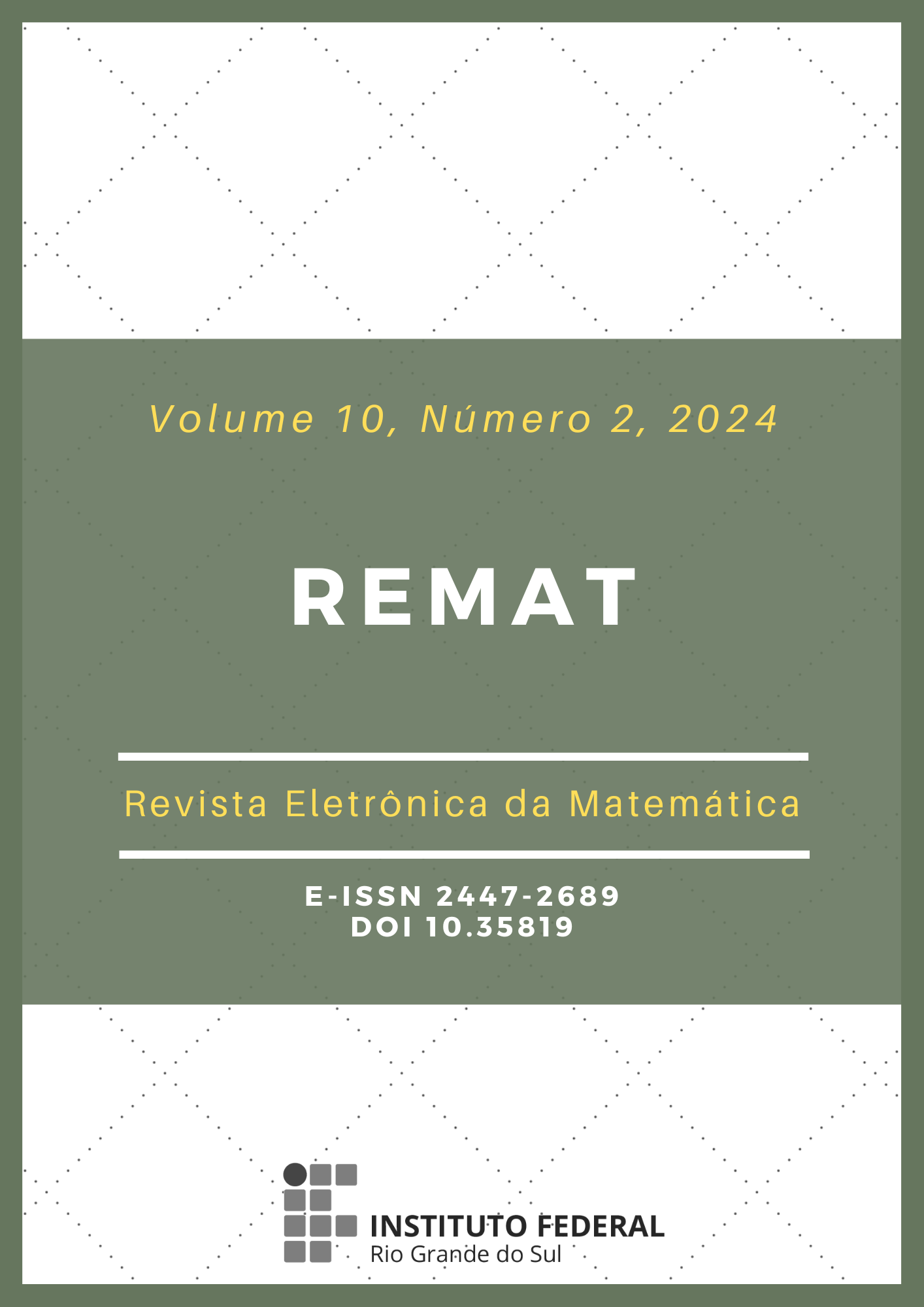Synchronism in a metapopulation aggregation model with convex nonlinear coupling
DOI:
https://doi.org/10.35819/remat2024v10i2id6926Keywords:
metapopulation, stability, synchronism, Lyapunov number, convex combinationAbstract
The present work is part of the result of the author's doctoral dissertation and aims at presenting a metapopulational aggregation model with a density-independent migration rate that allows the choice of the destination site according to its density. A non-linear coupling is produced here, formed by a convex combination of two matrices, one with a local connection and the other with a global connection. The result obtained here guarantees the asymptotic stability of the synchronized attractor and also that the transverse Lyapunov number of the synchronized attractor is given by the product of the orbital Lyapunov number by a quantifier that depends on the migration rate and the eigenvalues of an originating matrix of the connection matrix. From the numerical simulations of the variation of the transversal Lyapunov number in relation to the parameters migration rate and intrinsic reproduction rate of the function that describes the local dynamics, the regions of possible and impossible synchrony are measured. With the simulations of the synchronized orbit with respect to small perturbations, the values of the intrinsic reproduction rate and the migration rate are determined, for which the most synchronization occurs, and it is also determined that there is no synchronization of chaotic orbits.
Downloads
References
ALLEN, J. C.; SCHAFFER, W. M.; ROSKO, D. Chaos reduces species extinction by amplifying local population noise. Nature, [s. l.], v. 364, p. 229-232, 1993. DOI: https://doi.org/10.1038/364229a0.
BARRIONUEVO, J. A.; SILVA, J. A. L. Stability and synchronism of certain coupled dynamical systems. SIAM Journal on Mathematical Analysis, [s. l.], v. 40, n. 3, p. 939-951, 2008. DOI:https://doi.org/10.1137/060658436.
DAVIS, P. J. Circulant Matrices. New Jersey: John Wiley & Sons, 1979. Disponível em: https://archive.org/details/isbn_9780471057710. Acesso em: 10 jul. 2024.
DIAS, F. H. S. Estudo da sincronização de novos modelos metapopulacionais com acoplamento não linear. Orientador: Jacques Aveline Loureiro da Silva. 2018. 141 f. Tese (Doutorado em Matemática Aplicada) - Programa de Pós-Graduação em Matemática Aplicada, Universidade Federal do Rio Grande do Sul, Porto Alegre, 2018. DOI: https://lume.ufrgs.br/handle/10183/189363.
DIAS, F. H. S.; SILVA, J. A. L. Sincronismo em um novo modelo metapopulacional com migração independente da densidade. Proceeding Series of the Brazilian Society of Computational and Applied Mathematics, São Carlos, v. 6, n. 1, 2018. DOI: https://doi.org/10.5540/03.2018.006.01.0432.
DÍAZ, L. J.; JORGE, D. R. Uma introdução aos Sistemas Dinâmicos via funções Contínuas. Rio de Janeiro, RJ: Instituto Nacional de Matemática Pura e Aplicada, 2007. Disponível em: https://impa.br/wp-content/uploads/2017/04/26CBM_17.pdf. Acesso em: 10 jul. 2024.
EARN, D. J. D.; LEVIN, S. A.; ROHANI, P. Coherence and conservation. Science, [s. l.], v. 290, n. 5495, p. 1360-1364, 2000. DOI: https://www.science.org/doi/10.1126/science.290.5495.1360.
ECKMANN, J. -P.; RUELLE, D. Ergodic Theory of chaos and strange attractors. Reviews of Modern Physics, [s. l.], v. 57, n. 3, p. 617-656, 1985. DOI: https://doi.org/10.1103/RevModPhys.57.617.
HANSKI, I. Metapopulation dynamics. Nature, [s. l.], v. 396, p. 41-49, 1998. DOI: https://doi.org/10.1038/23876.
HANSKI, I.; ZHANG, D.-Y. Migration, metapopulation dynamics and fugitive co-existence. Journal of Theoretical Biology, [s. l.], v. 163, n. 4, p. 491-504, 1993. DOI: https://doi.org/10.1006/jtbi.1993.1134.
HASSEL, M. P. Density-dependence in single-species populations. Journal of Animal Ecology, [s. l.], v. 44, n. 1, p. 283-295, 1975. DOI: https://doi.org/10.2307/3863.
HASSEL, M. P.; LAWTON, J. H.; MAY, R. M. Patterns of dynamical behaviour in single-species populations. Journal of Animal Ecology, [s. l.], v. 45, n. 2, p. 471-486, 1976. DOI: https://doi.org/10.2307/3886.
HASSEL, M. P.; MIRAMONTES, O.; ROHANI, P.; MAY, R. M. Appropriate Formulations for Dispersal in Spatially Structured Models: Comments on Bascompte & Sole. Journal of Animal Ecology, [s. l.], v. 64, n. 5, p. 662-664, 1995. DOI: https://doi.org/10.2307/5808.
KAHILAINEN, A.; VAN NOUHUYS, S.; SCHULZ, T.; SAASTAMOINEN, M. Metapopulation dynamics in a changing climate: Increasing spatial synchrony in weather conditions drives metapopulation synchrony of a butterfly inhabiting a fragmented landscape. Global Change Biology, [s. l.], v. 24, n. 9, p. 4316-4329, 2018. DOI: https://doi.org/10.1111/gcb.14280.
LEVINS, R. Some demographic and genetic consequences of environmental heterogeneity for biological control. Bulletin of Entomological Society of America, [s. l.], v. 15, n. 3, p. 237-240, 1969. DOI: https://doi.org/10.1093/besa/15.3.237.
MURRAY, J. D. Mathemathical Biology. 2. ed. Berlin: Springer, 1996. Disponível em: https://link.springer.com/book/10.1007/978-3-662-08542-4. Acesso em: 16 jul. 2024.
OLIVEIRA, K. Um primeiro curso sobre teoria ergódica com aplicações. Rio de Janeiro, RJ: IMPA, 2005. Disponível em: https://impa.br/wp-content/uploads/2017/04/25CBM_14.pdf. Acesso em: 16 jul. 2024.
PIKOVSKY A.; ROSENBLUM, M.; KURTHS, J. Synchronization: A Universal Concept in Nonlinear Sciences. Cambridge: Cambridge University Press, 2001. Disponível em: ww.cambridge.org/9780521592857. Acesso em: 12 ago. 2024.
ROHANI, P.; RUXTON, G. D. Dispersal-induced instabilities in host-parasitoid metapopulations. Theoritical Population Biology, [s. l.], v. 55, n. 1, p. 23-36, 1999. DOI: https://doi.org/10.1006/tpbi.1998.1389.
SILVA, J. A. L. Cluster formation in a heterogeneous metapopulation model. Journal of Mathematical Biology, [s. l.], v. 72, n. 6, p. 1531-1553, 2016. DOI: https://doi.org/10.1007/s00285-015-0916-x.
SILVA, J. A. L.; BARRIONUEVO, J. A.; GIORDANI, F. T. Synchronism in population networks with nonlinear coupling. Nonlinear Analysis: Real World Applications, [s. l.], v. 11, n. 2, p. 1005-1016, 2010. DOI: https://doi.org/10.1016/j.nonrwa.2009.01.036.
UCHMA´NSKI, J. Individual variability and metapopulation dynamics: An individual-based model. Ecological Modelling, [s. l.], v. 334, n. 1, p. 8-18, 2016. DOI: https://doi.org/10.1016/j.ecolmodel.2016.04.019.
Downloads
Published
Issue
Section
License
Copyright (c) 2024 REMAT: Revista Eletrônica da Matemática

This work is licensed under a Creative Commons Attribution 4.0 International License.
REMAT retains the copyright of published articles, having the right to first publication of the work, mention of first publication in the journal in other published media and distribution of parts or of the work as a whole in order to promote the magazine.
This is an open access journal, which means that all content is available free of charge, at no cost to the user or his institution. Users are permitted to read, download, copy, distribute, print, search or link the full texts of the articles, or use them for any other legal purpose, without requesting prior permission from the magazine or the author. This statement is in accordance with the BOAI definition of open access.













 https://orcid.org/0000-0002-0893-7426
https://orcid.org/0000-0002-0893-7426


















